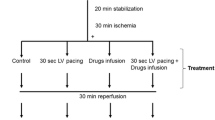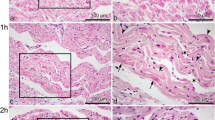Summary
We compared the effects of repeated short periods of myocardial ischemia with those of permanent occlusion (canine open-chest) with regard to tissue content of adenine nucleotides, nucleosides, creatine phosphate, and ultrastructure. Coronary occlusion for 3 min followed by a reperfusion period of 7 min was repeated up to a cumulative occlusion time of either 45 or 90 min. After cumulative occlusions of 15, 30, 45, and 90 min, transmural needle biopsies were taken from the ischemic area to be analyzed for adenine nucleotides, nucleosides, creatine phosphate, and ultrastructural changes. At the end of each experiment, tetrazolium salt staining was used for macroscopic detection of myocardial necrosis. These data were obtained with those obtained from dogs with a permanent coronary occlusion of 45 and 90 min, respectively. After repeated coronary occlusions at a cumulative occlusion time of 45 min, macroscopic detection of necrosis was negative, and after 90 min of cumulative coronary occlusion, patchy subendocardial tissue necrosis was found in only one out of 13 dogs, whereas in the group with permanent coronary occlusion, small patchy subendocardial necrosis was found in 95% after 45 min, and after 90 min permanent coronary occlusion, large subendocardial necrotic areas spreading towards the epicardial layers were found in 90% of the hearts.
Ultrastructural investigations showed only slight to moderate ischemic injury after 45 and 90 min intermittent coronary occlusion, whereas permanent coronary occlusion produced moderate to severe ischemic injury after 45 min; and 90 min permanent coronary occlusion produced irreversible ischemic injury in all subendocardial tissue samples and in 80% of the subepicardial tissue samples.
ATP content was decreased significantly less during intermittent coronary occlusion compared with that during permanent coronary occlusion.
AMP and nucleosides did accumulate during permanent occlusion but not with repetitive brief coronary occlusions. Our results show that intermittent reperfusion significantly delays ischemic injury in comparison with permanent coronary occlusion.
Similar content being viewed by others
References
Benson SE, Evans GT, Hallaway BE, Phibbs C, Freier EF (1961) Myocardial creatine phosphate and nucleotides in anoxic cardiac arrest and recovery. Am J Physiol 202:687–693
Braasch W, Gudbjarnason S, Puri PS, Ravens KG, Bing RJ (1968) Early changes in energy metabolism in the myocardium following acute coronary artery occlusion in anesthetized dogs. Circ Res 23:429–438
Whalen DA, Hamilton DG, Ganote CE, Jennings RB (1974) Effect of a transient period of ischemia on myocardial cells. Effect on cell volume regulation. Am J Pathol 74:381–389
Jennings RB, Reimer KA, Hill ML, Majo SE (1981) Total ischemia in dog hearts, in vitro. 1. Comparison of high energy phosphate production, utilization and depletion, and of adenine nucleotide catabolism in total ischemia in vitro vs. severe ischemia in vivo. Circ Res 49:892–900
Schaper W, Frenzel H, Hort W, Winkler B (1979) Experimental coronary artery occlusion. II. Spatial and temporal evolution of infarcts in the dog heart. Basic Res Cardiol 74:233–239
Schaper J, Mulch J, Winkler B, Schaper W (1979) Ultrastructural, functional, and biochemical criteria for estimation of reversibility of ischemic injury: A study on the effects of global ischemia on the isolated dog heart. J Mol Cell Cardiol 11:521–541
Geft IL, Fishbein HC, Ninomiya Kenji, Hashida J, Chaux E, Yamo J, Y-Rit J, Gesov T, Shell W, Ganz W (1982) Intermittent brief periods of ischemia have a cumulative effect and may cause myocardial necrosis. Circulation 66:1150–1153
Biagini A, Carpeggian C, Mazzei G, Yachelli GC, Bazzigal G, L'Abbate A, Maseri A (1980) Myocardial cell damage during Vasospastic anginal attacks with promptly reversible electrocardiographic changes. Am J Cardiol 45:455–459
Reimer KA, Hill ML, Jennings RB (1981) Prolonged depletion of ATP and of the adenine nucleotide pool due to delayed resynthesis of adenine nucleotides following reversible myocardial ischemia injury in dogs. J Mol Cell Cardiol 13:229–239
Nienaber C, Gottwik M, Winkler B, Schaper W (1983) The relationship between the perfusion deficit, infarct size and time after experimental coronary artery occlusion. Basic Res Cardiol 78:210–226
Maroko PR, Kjekshus JK, Sobel BE, Watanabe T, Covell JW, Ross J, Braunwald E (1971) Factors influencing infarct size following experimental coronary artery occlusion. Circulation 43:67–82
Hoffmeister HM, Mauser M, Schaper W (1986) Repeated short periods of regional myocardial ischemia: effect on local function and high energy phosphate levels. Basic Res Cardiol 81:361–372
Swain JL, Hines JJ, Sabina RL, Holmes EW (1982) Accelerated repletion of ATP and GTP pools in postischemic canine myocardium using a precursor of purine de-novo synthesis. Circ Res 51:102–105
Lange R, Ingwall J, Hale SL, Alker KJ, Kloner RA (1984) Effects of recurrent ischemia on myocardial high energy phosphate content in canine hearts. Basic Res Cardiol 79:469–478
Murry CE, Reimer KA, Long JB, Jennings RB (1985) Preconditioning with ischemia protects ischemic myocardium. Circulation 72, Suppl III:475
Ito BR, Tate H, Schaper W (1985) Regional myocardial function and oxygen consumption following transient coronary artery occlusion in the dog. Z Kardiol 74 (Suppl 3):69
Ito BR, Tate H, Schaper W (1985) Calcium induced increases in regional contractile function before and after transient coronary occlusion in the dog. Circulation 72 (Suppl III):III-68
Author information
Authors and Affiliations
Rights and permissions
About this article
Cite this article
Henrichs, K.J., Matsuoka, H. & Schaper, J. Influence of repetitive coronary occlusions on myocardial adenine nucleosides, high energy phosphates and ultrastructure. Basic Res Cardiol 82, 557–565 (1987). https://doi.org/10.1007/BF01907226
Received:
Issue Date:
DOI: https://doi.org/10.1007/BF01907226




